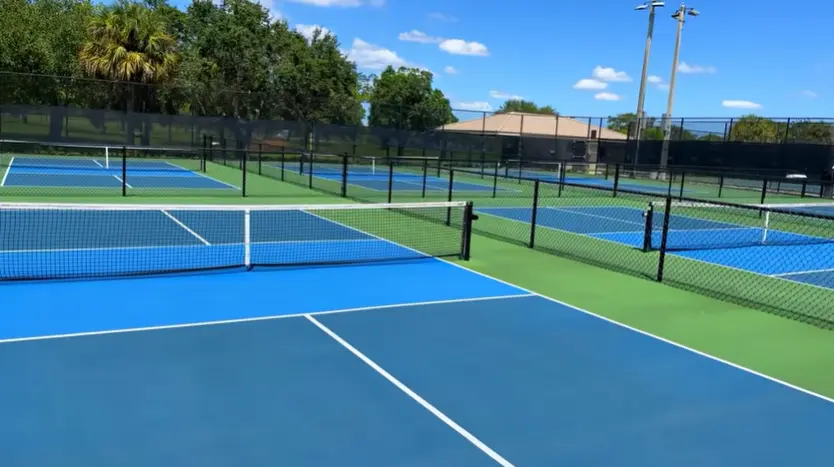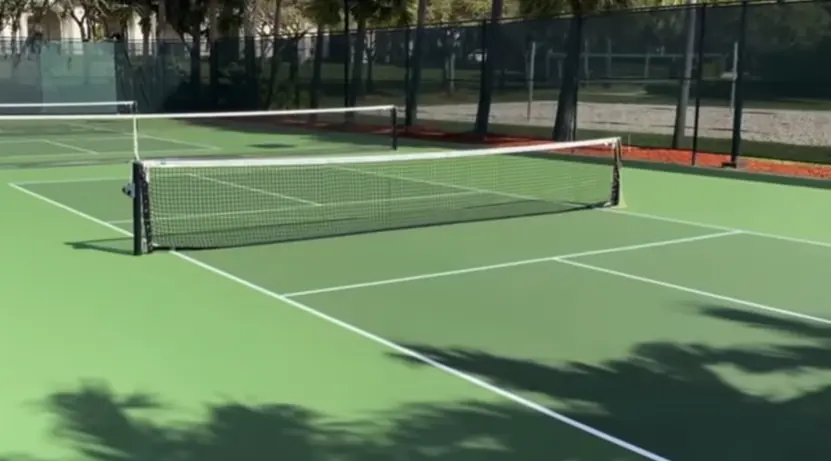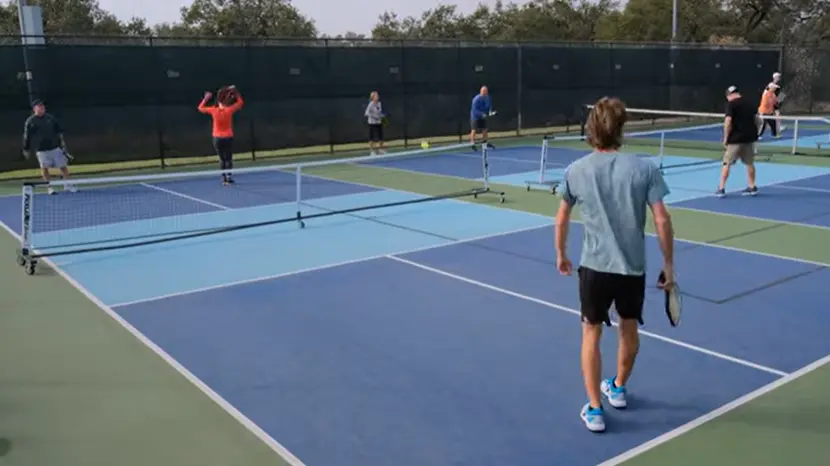Hey there, pickleball enthusiasts and tennis court owners! If you’re like me, you’ve probably noticed the growing popularity of pickleball and the increasing demand for suitable pickleball courts.
As a result, many pickleball players have resorted to using tennis courts, mainly because pickleball-specific courts are still relatively scarce. However, this situation has raised concerns about potential damage to tennis courts.
In this article, we’ll explore whether pickleball poses any real threat to tennis court surfaces and what you can do to ensure the longevity of your beloved courts.
Do Not Forget to Read: Overall Best Pickleball Paddles
Does Pickleball Damage Tennis Courts
Now, let’s get one thing straight right off the bat: pickleball itself does not inherently damage tennis courts.
Tennis courts are designed to withstand intense gameplay, and pickleball, being a less strenuous sport, typically poses minimal risks to their structural integrity.
However, there’s a catch. Issues can arise when pickleball lines are marked on tennis courts using temporary tape.
To shed some light on the matter, let me share an interesting case study. In Gilroy, California, the use of temporary tape for pickleball lines on tennis courts resulted in an estimated $10,000 worth of damage.

Ouch! That’s definitely not something any court owner wants to deal with. This incident sparked further research into the impact of pickleball on tennis courts, as both players and court owners wanted to know the potential risks involved.
Now, you might be wondering if pickleball paddles themselves could be the culprits behind any damage. Well, fear not! Pickleball paddles, even with their sturdy construction, do not harm tennis courts when used to play the game.
The real issue lies with the temporary tape used to mark the pickleball lines. Over time, this tape can leave residue and cause damage to the court surface, resulting in costly repairs.
Do Not Forget to Read: Best Pickleball Paddle for Tennis Players
Understanding the Similarities and Differences
Pickleball and tennis share similarities as racquet sports played on hard courts, clay, or grass. However, they differ in court dimensions and net heights.
Modifying a tennis court for pickleball requires new lines, adjusted net heights, and the ability to fit two pickleball courts into one tennis court.
These modifications can lead to availability concerns and potential damage, causing controversy among players of both sports.
Examining the Evidence
Despite concerns, there is no evidence suggesting that playing pickleball on a tennis court causes damage to the court surface, net, or pre-determined lines.
Tennis courts are designed to withstand various ball and racquet sports, including pickleball, without significant harm. The soft plastic Wiffle ball used in pickleball is unlikely to cause damage to tennis courts due to its material properties.
Similarly, pickleball paddles, typically made of wood, do not pose a threat to tennis courts. While paddles may get damaged themselves, they do not cause harm to the court surfaces. It is crucial to note that proper play is essential to avoid any potential damage.
When pickleballs hit the ground, they may create small divots on the court surface. However, if promptly fixed, these divots will not result in lasting damage.
Case Study: Gilroy, California
One recorded case from Gilroy, California, highlighted the potential risks associated with temporary adhesive used for pickleball lines on tennis courts.
The adhesive caused permanent damage, leading to tensions between tennis and pickleball players. This case emphasizes the importance of using temporary markings that can be easily removed without causing harm to the court surface.
Factors Minimizing Potential Damage
Pickleballs, with their soft plastic material, contribute to reducing wear and tear on tennis courts compared to other balls used in racquet sports.
The softer material of pickleballs reduces the impact on the court surface, decreasing the likelihood of significant damage.

Additionally, pickleballs generate less friction than fuzzy tennis balls, further minimizing the potential harm to tennis court surfaces. These factors combined make pickleballs less likely to cause significant damage to the court.
Precautions to Minimize Risks
While pickleballs are generally less damaging to tennis courts, it is still important to take certain precautions to minimize the risk of damage.
Proper maintenance and prompt repair of any divots or damages caused by pickleballs are essential. Regular inspections of the court surface should be conducted, and any necessary repairs should be carried out promptly to prevent further deterioration.
Furthermore, temporary line markings used for pickleball on tennis courts should be removed after play. Leaving multiple lines on the court can create confusion and frustration for tennis players.
It is crucial to ensure that temporary markings are erased to maintain a clean and visually unobstructed court surface.
By preventing any permanent damage, the overall integrity and lifespan of the tennis court can be preserved.
Further Information: Graphite Vs Fiberglass Pickleball Paddles
Alternative Options and Benefits of Playing Pickleball on a Tennis Court
If tennis courts are not available, there are alternative options for playing pickleball. Badminton courts, with their similar dimensions, can accommodate pickleball.
While the net is higher in badminton, portable tennis nets can be used to lower the net height for pickleball play.
Another option is to play on dedicated pickleball courts that are specifically designed for the game. These courts offer a smooth, level surface that is gentle on pickleballs and provides an optimal playing experience.
Playing pickleball on a tennis court offers several benefits. It allows players to enjoy the game and reap the benefits of playing tennis without the need for additional equipment.
Pickleball on a tennis court can help improve tennis skills as it involves similar gameplay with a lower net and smaller court. Additionally, pickleball provides a cardio workout, enhances hand-eye coordination, and offers an opportunity to have fun and socialize with friends.
A Helpful Guide: How Much Does It Cost To Build A Pickleball Court?
The Cost of Repairing Damage to a Tennis Court Caused by Pickleball
While pickleball may be gentler on tennis courts compared to other sports, there is still a cost associated with repairing any damage that may occur.
On average, the cost of repairing damage caused by pickleball ranges from $1,947 to $10,061, with an average cost of $6,004. It is important to note that the repair costs may vary depending on the location.
As pickleball is a relatively new sport, the long-term damage costs are not yet fully known. However, players should be prepared for potential repair bills if they choose to play pickleball on a tennis court.
Prevention of Damage to Tennis Courts During Pickleball Play
To prevent damage to a tennis court when playing pickleball, certain measures can be taken. Using pickleballs that are specifically designed for the game, made of softer material, can help protect the court surface.
Additionally, using pickleball paddles with rounded edges can prevent scratching the court surface or paint. It is also important to sweep the court after each pickleball session to remove any debris that could potentially damage the surface.

Regular maintenance of the net, including cleaning it on days without gameplay, helps to preserve its condition.
Furthermore, removing leaves, weeds, branches, rocks, and other debris regularly prevents moisture and algae growth on the court, reducing the risk of damage.
If spots or stains appear on the court surface, using a pressure washer with the appropriate nozzle can effectively remove them without causing scars.
Further Information: Can You Play Pickleball On A Tennis Court
Is Pickleball louder than tennis?
While pickleball strikes have a higher pitch and can be more audibly distinct from a distance compared to tennis, it is important to consider the impact of pickleball on tennis courts.
It is worth noting that the overall noise level of a pickleball game can vary depending on factors such as the type of ball, playing style, and court conditions.
While pickleball strikes may have a more distinctive sound due to the materials used in constructing pickleballs, the perception of pickleball being louder than tennis should be considered in context.
The noise difference is primarily due to the higher frequency of pickleball strikes, making them more audibly recognizable from a distance.
However, the noise level experienced during both sports ultimately depends on various factors and can differ in different playing environments.
What’s The Best Surface to Play Pickleball On?
The best surface for pickleball is a level, cushioned, and shock-absorbing one, preferably coated with flexible acrylic binders. Tennis courts can meet these criteria, but it is crucial to take preventive measures to minimize potential damage.
To protect tennis courts during pickleball play, it is recommended to use appropriate equipment and follow maintenance practices. Pickleballs are designed to be gentler on court surfaces, but precautions should still be taken.
Regular inspections and prompt repairs of any divots or damages caused by pickleball play are essential. Temporary line markings should be removed after play to avoid confusion and frustration for tennis players.
By adhering to these practices, pickleball enthusiasts can enjoy the game while minimizing the risk of damage to tennis courts.
Further Information: Difference Between Indoor And Outdoor Pickleball Balls
Conclusion
Pickleball does not inherently damage tennis courts. Tennis courts are designed to withstand various racquet sports, including pickleball, without significant harm. However, precautions should be taken to protect the court surface and prevent potential damage.
Temporary line markings used for pickleball should be removed promptly to avoid causing confusion and frustration for tennis players. Regular inspections and repairs of any divots or damages caused by pickleball play are crucial to maintain the integrity of the court.
Using appropriate equipment, such as softer pickleballs and paddles with rounded edges, can further minimize the risk of damage.
Additionally, regular maintenance practices, including sweeping the court, cleaning the net, and removing debris, help preserve the court’s condition and prevent moisture-related issues.
While pickleball strikes may produce a higher pitch and be more audibly distinct from a distance, the overall noise level of both pickleball and tennis depends on various factors and can differ in different playing environments.
By following these preventive measures, pickleball enthusiasts can enjoy the game while protecting the longevity of tennis courts.

Michael Stevenson
Hi, my name is Michael Stevenson and I’m a passionate pickleball player. I’ve been playing the game for many years and I’m pretty highly skilled at it. Pickleball is one of my favorite topics so naturally, I love to write about it.
Whether it’s tips for beginners, guides for experts, reviews of new paddles, or advanced playing techniques – if it relates to pickleball then I have something interesting to write about it. So if you’re looking for entertaining and informative information on the topic of pickleball, look no further than my written works!